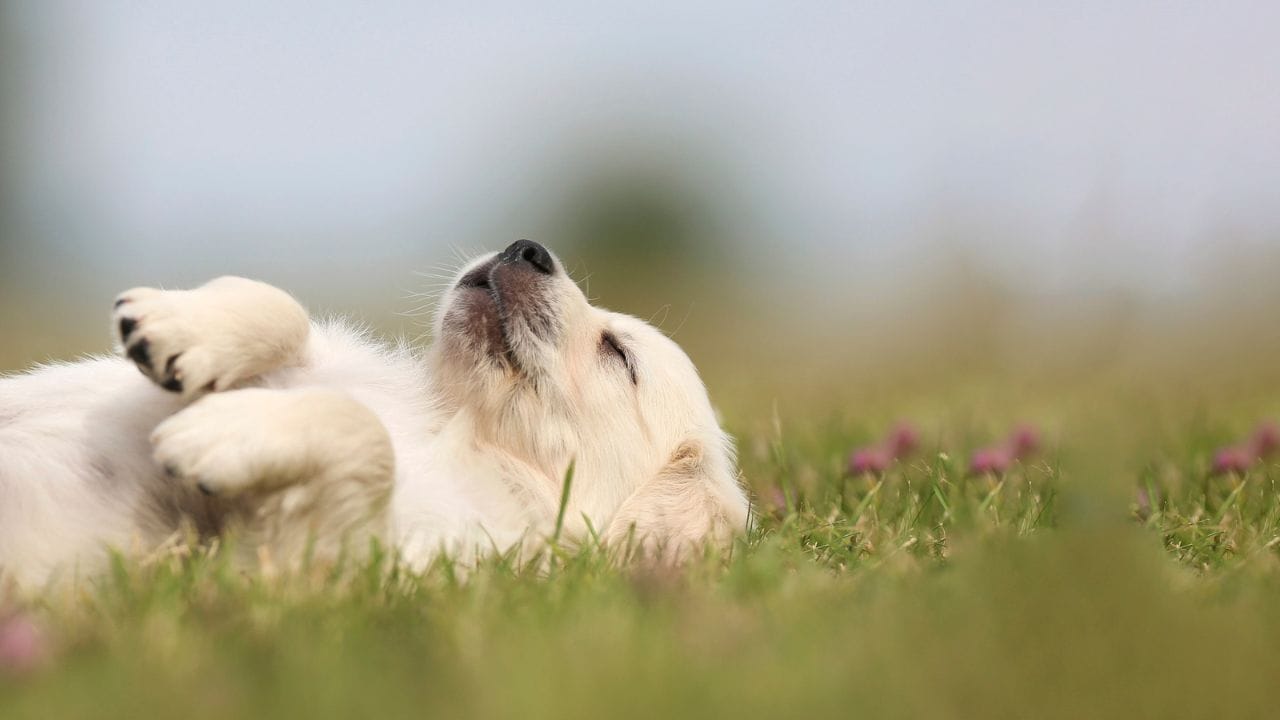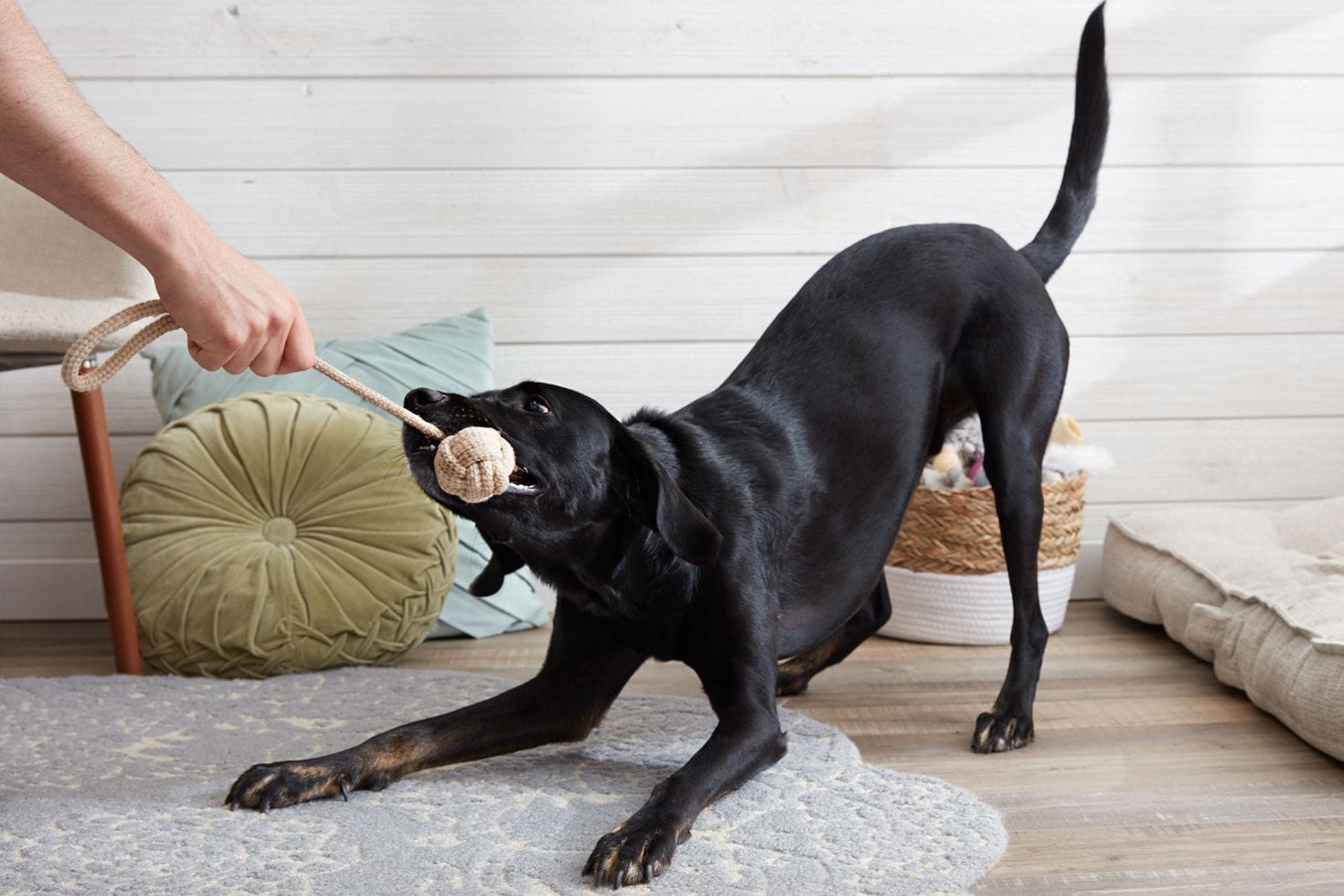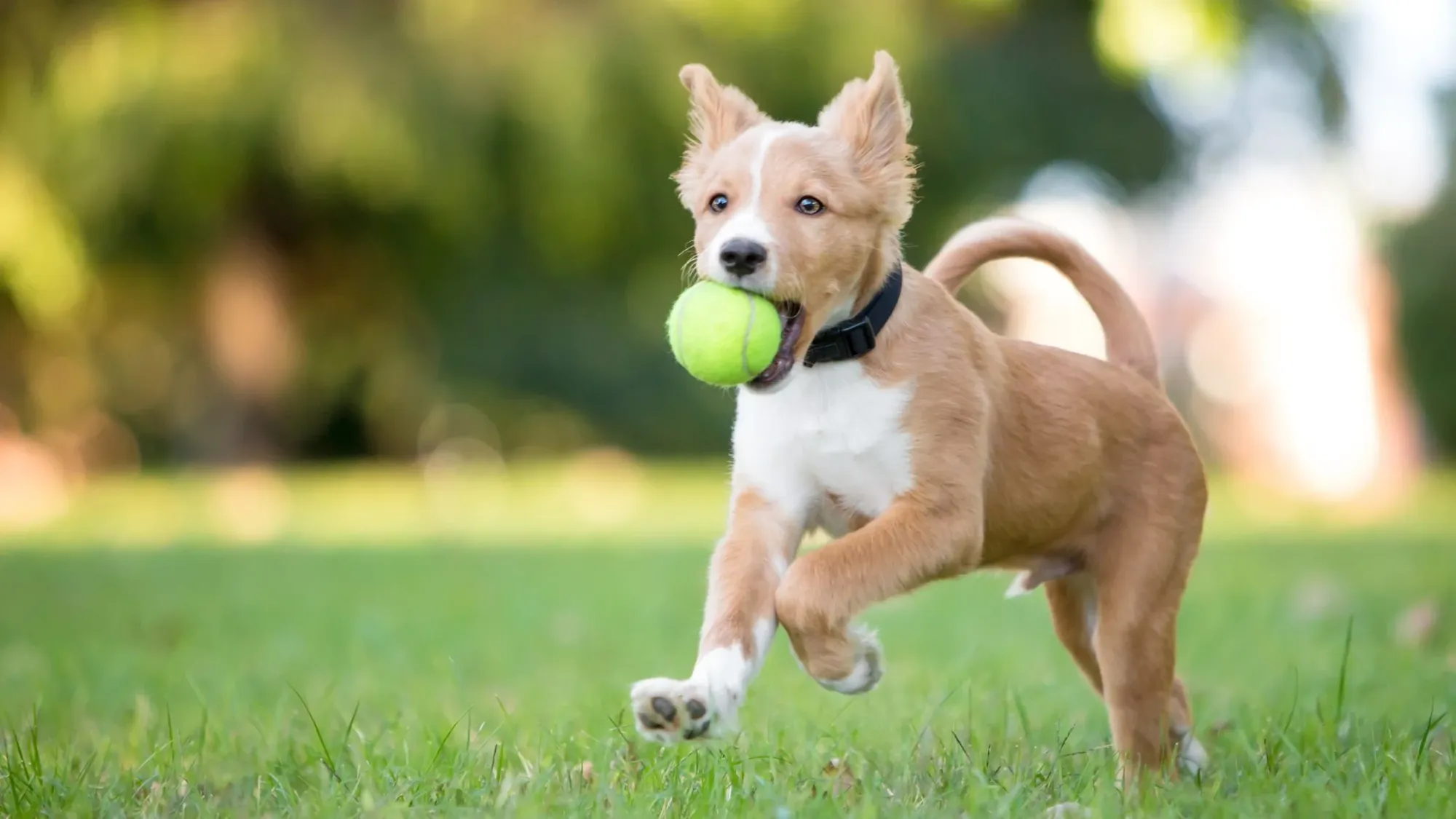Playing with a puppy can be a fun and rewarding experience for both the puppy and the owner. However, it is important to remember that puppies are still learning and developing, and their playtime should be approached with care and consideration. In this article, we will provide some tips and guidelines on how to play with a puppy in a safe and enjoyable way.

First and foremost, it is important to establish some ground rules for playtime. Puppies can be very energetic and may not understand boundaries, so it is important to set limits and reinforce them consistently. For example, if your puppy starts biting or nipping during play, it is important to redirect their attention to a toy or other appropriate object. It is also important to avoid rough play or wrestling, as this can lead to injuries or aggressive behavior.
When playing with a puppy, it is important to provide plenty of opportunities for socialization and exploration. This can include introducing your puppy to new people, animals, and environments, as well as providing toys and other objects for them to play with. By encouraging your puppy to explore and interact with their environment, you can help them develop confidence and independence, as well as strengthen your bond with them.
Understanding Puppy Behavior
Puppies are adorable, playful, and curious creatures that bring joy to their owners. However, understanding their behavior is essential to ensure they grow into well-behaved adult dogs. In this section, we will discuss the importance of play for puppies, common play behaviors, and signs of overstimulation and aggression.
Importance of Play for Puppies
Play is a crucial part of a puppy's social and mental development. It helps them learn about their environment, develop coordination and motor skills, and build social skills. Puppies that do not receive enough playtime can become bored, anxious, and develop destructive behaviors.
Common Play Behaviors
Puppies have different play styles, and it is essential to understand them to interact with them properly. Some common play behaviors include:
- Chasing: Puppies love to chase moving objects, such as balls or toys, and enjoy being chased.
- Tug-of-war: Puppies enjoy playing tug-of-war with toys, but it is essential to teach them to release the toy on command.
- Wrestling: Puppies like to play-fight with their littermates or other dogs and enjoy roughhousing.
- Fetch: Puppies enjoy fetching toys and bringing them back to their owners.
Signs of Overstimulation and Aggression
Puppies can become overstimulated during playtime, leading to aggressive behavior. Some signs of overstimulation and aggression include:
- Growling or snarling
- Biting or nipping
- Barking excessively
- Jumping up on people
If a puppy displays any of these behaviors, it is essential to stop playtime and redirect their attention to a different activity. It is also crucial to socialize puppies with other dogs and people to reduce the risk of aggressive behavior.
Understanding puppy behavior is essential to ensure they grow into well-behaved adult dogs. By providing them with enough playtime, understanding their play behaviors, and recognizing signs of overstimulation and aggression, owners can raise happy and healthy puppies.

Preparing for Playtime
Before playing with a puppy, it is important to prepare a safe and controlled environment for them to play in. This section will cover the three main aspects of preparing for playtime: creating a safe play environment, choosing appropriate toys, and setting up for structured play.
Creating a Safe Play Environment
It is essential to create a safe play environment for puppies to prevent them from getting hurt or ingesting harmful objects. Here are a few tips to create a safe play environment:
- Remove any household items that could be dangerous for the puppy to play with, such as sharp objects or toxic substances.
- Keep electrical cords and wires out of reach to prevent the puppy from chewing on them.
- Use baby gates or playpens to block off areas that are not puppy-proofed.
Choosing Appropriate Toys
Choosing the right toys for a puppy is crucial for their safety and enjoyment. Here are a few tips for choosing appropriate toys:
- Avoid toys that are too small or easily breakable and could be swallowed or cause choking hazards.
- Look for toys that are made of durable materials and are specifically designed for puppies.
- Choose toys that are easy for the puppy to grip and play with.
Setting Up for Structured Play
Structured playtime is essential for a puppy's mental and physical development. Here are a few tips for setting up for structured play:
- Choose a designated play area where the puppy can play without any distractions.
- Use positive reinforcement techniques to encourage the puppy to play and learn.
- Incorporate training exercises into playtime to help the puppy learn new skills.
By following these tips, you can prepare for a safe and enjoyable playtime with your puppy.
Types of Play and Games
Playing with a puppy is a great way to bond and provide them with the physical and mental stimulation they need. There are many types of play and games that you can engage in with your furry friend. Here are a few examples:
Tug-of-War and Its Rules
Tug-of-War is a classic game that many dogs love. It's important to establish some rules before playing this game. Firstly, you should use a designated tug toy rather than any random object. Secondly, the game should only be played when the puppy is calm and not overly excited. Lastly, you should teach your puppy to release the toy on command.

Fetch and Chase Games
Fetch and chase games are great for providing your puppy with exercise and mental stimulation. You can use a ball, frisbee, or any other toy that your puppy enjoys. It's important to start these games in a safe, enclosed area to prevent your puppy from running off. You can also use these games to practice basic commands such as "come" and "stay."
Puzzle Toys and Mental Stimulation
Puzzle toys are a great way to provide your puppy with mental stimulation. These toys often involve hiding treats or kibble inside them, which your puppy has to figure out how to get to. This type of play can help with problem-solving skills and prevent boredom.
Using a Flirt Pole
A flirt pole is a pole with a toy attached to the end of a string. It's a great way to provide your puppy with exercise and mental stimulation. You can use the flirt pole to play chase or tug-of-war games. It's important to supervise your puppy when using a flirt pole and to avoid over-exertion.
Overall, playing with your puppy can be a fun and rewarding experience for both you and your furry friend. By engaging in different types of play and games, you can provide your puppy with the physical and mental stimulation they need to stay happy and healthy.
Training Through Play
Playing with your puppy is not only a fun way to bond with your furry friend, but it can also be an effective way to train them. Incorporating training into playtime can help your puppy learn basic commands and develop good habits. Here are some tips on how to train your puppy through play.
Teaching Basic Commands
Teaching your puppy basic commands such as "sit," "stay," and "come" is an essential part of their training. You can incorporate these commands into your playtime routine by asking your puppy to perform the command before engaging in play. For example, ask your puppy to "sit" before throwing a ball or "come" before giving them a treat.
When teaching your puppy commands, it's important to use positive reinforcement. Reward your puppy with praise, treats, or toys when they successfully perform the command. This will encourage them to continue to obey and learn new commands.
Incorporating Obedience into Play
Playing games that require your puppy to be obedient can also be a great way to train them. For example, playing fetch can help your puppy learn to come when called and drop objects on command. You can also play games like hide-and-seek, which can help your puppy learn to stay and come when called.
When playing obedience games, it's important to be consistent with your commands and rewards. Use the same commands and rewards every time you play the game to help your puppy learn and understand what is expected of them.
Bite Inhibition and Chew Training
Puppies love to chew, but it's important to teach them what is and isn't appropriate to chew on. Incorporating chew training into playtime can help your puppy learn to chew on appropriate objects, such as toys, and avoid chewing on furniture or other items.
When your puppy starts to chew on something they shouldn't, redirect their attention to an appropriate chew toy. Praise them when they chew on the toy and ignore them when they chew on inappropriate objects.
Another important aspect of training through play is teaching your puppy bite inhibition. Puppies often use their mouths to explore and play, but it's important to teach them not to bite too hard. When your puppy bites too hard during play, yelp or say "ouch" to let them know it hurts. This will teach them to be more gentle and avoid biting too hard in the future.
By incorporating training into playtime, you can help your puppy learn basic commands, develop good habits, and strengthen your bond with them. Remember to use positive reinforcement, be consistent with your commands and rewards, and teach your puppy appropriate chewing and biting behavior.
Socialization and Play
Playing with a puppy is a great way to bond and build a strong relationship with your furry friend. However, socialization is an important aspect of a puppy's development, and it should not be ignored. Here are some tips on how to socialize your puppy while playing with them.
Play with Other Dogs
Playing with other dogs is an excellent way to socialize your puppy. Taking your pup to a dog park or arranging playdates with other dogs can help your puppy learn how to interact with other dogs. It is essential to supervise the playtime to ensure that the dogs are compatible and playing nicely with each other.
Introducing New People and Environments
Introducing your puppy to new people and environments is an important part of socialization. It is crucial to expose your pup to different people, including children, adults, and seniors. Additionally, exposing your puppy to different environments, such as parks, beaches, and busy streets, can help them adjust to new situations.
Handling Overexcitement and Social Challenges
It is common for puppies to get overexcited during playtime, which can lead to social challenges. If your puppy becomes too excited or starts to show signs of aggression, it is essential to stop the playtime immediately. It is also crucial to teach your puppy proper play behaviors, such as not biting or jumping on people.
In conclusion, socialization and play are essential aspects of a puppy's development. By following these tips, you can help your puppy socialize, play with other dogs, and adjust to new environments. Remember to always supervise your puppy during playtime and handle any overexcitement or social challenges appropriately.
Health and Development Through Play
Playing with a puppy is not only fun, but it also has numerous health benefits. In this section, we will discuss the different ways play can contribute to a puppy's physical, cognitive, and sensory development.
Physical Exercise and Growth
Puppies need physical exercise to grow and develop properly. Playtime is an excellent way to provide them with the exercise they need. Activities such as fetch, tug-of-war, and running around in the yard can help puppies develop their muscles, improve their coordination, and increase their endurance. Additionally, physical exercise can help prevent obesity and other health problems.

Cognitive Skills and Memory Enhancement
Playtime can also improve a puppy's cognitive skills and memory. Interactive games such as hide-and-seek and puzzle toys can challenge a puppy's brain and improve their problem-solving skills. These types of games can also help puppies develop their memory and spatial awareness.
Sensory Play and Exploration
Sensory play and exploration are also important for a puppy's development. Puppies explore their world through their senses, and playtime can provide them with opportunities to do so. Activities such as digging, sniffing, and exploring different textures can help puppies develop their sense of smell and touch. Additionally, sensory play can help puppies develop their hunting and tracking instincts.
In conclusion, playtime is an essential part of a puppy's development. It provides them with physical exercise, improves their cognitive skills, and helps them explore their world through their senses. As a puppy owner, it is important to provide your puppy with ample opportunities to play and explore.
Addressing Problem Behaviors
Puppies are adorable, but they can also exhibit problem behaviors that can be frustrating for their owners. Here are some tips on how to address some of the most common problem behaviors.
Preventing and Managing Digging
Digging is a common behavior in dogs, and puppies are no exception. Puppies may dig for a variety of reasons, such as boredom or to hide their toys. To prevent digging, make sure your puppy has plenty of toys and exercise. You can also provide your puppy with a designated digging area, such as a sandbox. If your puppy does start to dig in an unwanted area, redirect them to their designated digging area.
Reducing Excessive Barking Through Play
Puppies may bark excessively when they are bored or anxious. To reduce excessive barking, make sure your puppy is getting enough exercise and mental stimulation. Playing with your puppy is a great way to provide both of these things. Try playing games such as fetch or hide and seek to keep your puppy entertained and engaged.
Dealing with Separation Anxiety
Separation anxiety is a common problem in puppies, especially when they are first introduced to a new home. To help your puppy adjust to being alone, start by leaving them alone for short periods of time and gradually increasing the length of time. Provide your puppy with plenty of toys and a comfortable place to rest while you are away. You can also try leaving a piece of clothing with your scent on it to comfort your puppy while you are gone.
By following these tips, you can help address some of the most common problem behaviors in puppies. Remember to be patient and consistent with your training, and seek professional help if needed.
Building a Strong Bond
Building a strong bond with your puppy is essential for a healthy and happy relationship. This section will discuss some of the key factors that contribute to a strong bond between you and your furry friend.
Understanding Your Puppy's Body Language
One of the most important aspects of building a strong bond with your puppy is understanding their body language. Dogs communicate through body language, and it's important to be able to read and interpret their signals. This will help you to understand their needs and desires, which will ultimately strengthen your bond.
Some common body language signals to look out for include tail wagging, ear position, and eye contact. A wagging tail usually indicates happiness, while a tucked tail can indicate fear or anxiety. Similarly, if your puppy's ears are up and forward, it typically means they are alert and interested in something. On the other hand, if their ears are back, it can indicate fear or submission.
The Role of Consistency and Routine
Consistency and routine are also crucial for building a strong bond with your puppy. Dogs thrive on routine and predictability, so it's important to establish a consistent daily routine for your puppy. This includes feeding, exercise, and playtime.
Consistency also applies to training. If you are consistent with your training methods, your puppy will learn faster and be more responsive to your commands. This will help to build trust and respect between you and your furry friend.
Fostering Trust and Companionship
Trust and companionship are the foundation of a strong bond between you and your puppy. To build trust, it's important to be patient, kind, and consistent with your puppy. Avoid harsh punishment or yelling, as this can damage your relationship and erode trust.
Companionship is also important for building a strong bond. Spend quality time with your puppy, whether it's playing, cuddling, or going for walks. This will help to strengthen your bond and create a sense of mutual trust and respect.
By understanding your puppy's body language, being consistent with routine and training, and fostering trust and companionship, you can build a strong bond with your furry friend that will last a lifetime.

Play Tips for Specific Breeds
Playing with a puppy can be a fun and rewarding experience, but it's important to remember that different breeds have different needs and personalities. Here are some play tips for specific breeds to help you get the most out of your playtime with your furry friend.
Adapting Play for Energetic Terriers
Terriers are known for their high energy levels and love of play. To keep them entertained, try incorporating games that involve chasing, fetching, and tugging. Terriers also enjoy puzzles and brain teasers, so consider investing in some interactive toys that will keep them mentally stimulated.
When playing with a terrier, it's important to keep an eye on their energy levels. If they start to get too worked up, it's time to take a break and let them calm down. Terriers can also be prone to rough play, so make sure to establish boundaries and use positive reinforcement to encourage good behavior.
Gentle Play for Sensitive Breeds
Some breeds, such as the Cavalier King Charles Spaniel and the Bichon Frise, are known for their sensitive natures. These dogs may be easily frightened or overwhelmed by loud noises or rough play.
To play with a sensitive breed, it's important to take a gentle approach. Stick to games that involve soft toys and gentle movements, such as hide-and-seek or gentle fetch. Avoid loud noises or sudden movements that could startle your pup.
Interactive Play for Intelligent Breeds
Intelligent breeds, such as the Border Collie and the Poodle, thrive on mental stimulation. These dogs enjoy games that challenge their minds, such as puzzle toys, obedience training, and agility courses.
When playing with an intelligent breed, it's important to keep them engaged and mentally stimulated. Try incorporating new games and activities into your playtime routine to keep things interesting. And remember, these dogs are quick learners, so be sure to use positive reinforcement to encourage good behavior.
Common Mistakes to Avoid
Playing with a puppy is a fun and rewarding experience, but it's important to avoid common mistakes that can hinder the process. Here are some mistakes to avoid when playing with your puppy.
Forcing Play When Puppy Isn't Interested
One common mistake that many new puppy owners make is forcing play when their puppy isn't interested. Puppies, like humans, have their own energy levels, and sometimes they just want to rest or relax. Forcing your puppy to play when they're not in the mood can cause them to become anxious or stressed.
To avoid this mistake, pay attention to your puppy's body language and energy level. If they seem tired or uninterested, give them some space and let them rest. You can always try to play with them later when they're more energetic and willing to engage.
Neglecting Puppy's Play Needs
Another mistake that many puppy owners make is neglecting their puppy's play needs. Puppies are energetic and require plenty of playtime to burn off their excess energy. Neglecting their play needs can lead to destructive behavior and other problems.
To avoid this mistake, make sure your puppy gets plenty of playtime each day. This can include playing fetch, tug-of-war, or other games that your puppy enjoys. You can also take your puppy for walks or runs to help them burn off energy.
Misjudging Puppy's Play Signals
Finally, many puppy owners make the mistake of misjudging their puppy's play signals. Puppies communicate through body language, and it's important to pay attention to their signals to avoid misunderstandings.
To avoid this mistake, learn to recognize your puppy's play signals. These can include wagging tails, play bows, and other body language cues. If your puppy seems hesitant or uncomfortable, take a step back and reassess the situation. It's important to make sure your puppy is comfortable and enjoying playtime.
By avoiding these common mistakes, you can ensure that your playtime with your puppy is fun, rewarding, and stress-free.
Conclusion
Playing with a puppy is an important aspect of puppyhood that pet owners should not overlook. It provides an opportunity for bonding, exercise, and mental stimulation. Puppy training can also be incorporated into playtime to reinforce good behavior and teach new commands.
When playing with a puppy, it is important to choose appropriate games and toys that are safe and engaging. Interactive toys, such as puzzle feeders and tug toys, can provide mental stimulation and promote healthy chewing habits. It is also important to supervise playtime to ensure the puppy does not become overly excited or aggressive.
Overall, playing with a puppy should be a fun and rewarding experience for both the pet owner and the puppy. By incorporating training and choosing appropriate toys, pet owners can ensure their puppy receives the necessary physical and mental exercise during this crucial stage of development.




